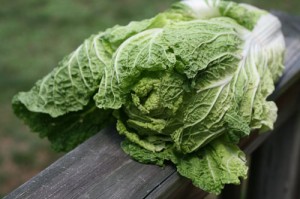I have a love/hate relationship with cabbage. If you know me or have read my story, you know that my daughters’ health problems were a catalyst for my journey into healing foods and nutrition. Struggling with their health problems was a very stressful time for me, which took a toll on my body in the form of an ulcer. Cabbage juice, turns out, is an ulcer remedy. For weeks, I drank 3-4 cups of it a day, and slowly my health improved. I love that I had proven to myself that foods can heal, but cabbage juice has a pungent, distinct taste that I haven’t been able to stomach since.
That is, until I found Napa cabbage (also known as Chinese cabbage), which is not pungent at all, making it a great variety to experiment with if you’re new to the cabbage family. It has a sweet flavor, and is useful for many types of inflammation and mucus symptoms. Unlike other forms of cabbage that are loaded with sulfur, Napa cabbage contains just 20% the sulfur of the round head varieties. If you can’t find Napa cabbage, try Savoy, another odor-less variety.
If you can stomach it, and many people can, the high sulfur content of round head cabbages is associated with blood purification and destroys parasites (a viable alternative if you are one of the many suffering from Lyme Disease).
In general, cabbage is great for the stomach, intestines and improving both digestion and constipation. It is excellent for cleansing, by rejuvenating the digestive track and neutralizing toxins. Cabbage, and cruciferous vegetables in general, have more anti-cancer phytochemicals than any other vegetable. Finally, cabbage is used in many cultures for beautifying the skin and is helpful in treating the common cold, mental depression and irritability. Though, I have to say it made me a bit irritable to drink it 4 times a day 🙂
Cabbage is rich in vitamin C, E, calcium and iodine. The flavor is at it’s peak during the cold, winter months when frost helps to develop a sweet flavor and crisp texture.
How to select it:
A cabbage head should be firm, heavy and dense with a vibrant, bright color. Leaves should be attached to the stem, and not wilted. Do not purchase pre-cut cabbage, it begins to lose vitamin content when it’s cut.
How to store it:
Store cabbage in the refrigerator in a plastic storage bag for optimal storage of 7 to 10 days. Do not wash cabbage prior to storage, as water will encourage spoilage.
How to prepare it:
Wash under cold water and remove the core. Slice and shred to add to soups, stews, salads, and any stir fry. This soba noodle stir fry is a favorite in my home. Cabbage can be added to smoothies, juiced, steamed, boiled and enjoyed as cole slaw. The strong smell and taste can be avoided by cooking it al dente.
All kidding aside, cabbage is a highly anti-inflammatory food and recommended for healthy eating.




